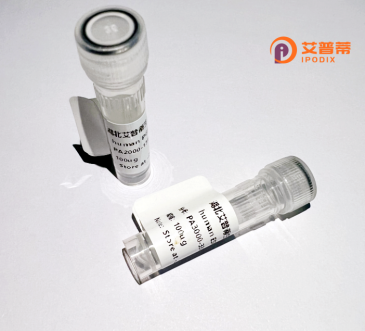
| 纯度 | >90%SDS-PAGE. |
| 种属 | Human |
| 靶点 | PTRH1 |
| Uniprot No | Q86Y79 |
| 内毒素 | < 0.01EU/μg |
| 表达宿主 | E.coli |
| 表达区间 | 1-214 aa |
| 活性数据 | MRPGGFLGAG QRLSRAMSRC VLEPRPPGKR WMVAGLGNPG LPGTRHSVGM AVLGQLARRL GVAESWTRDR HCAADLALAP LGDAQLVLLR PRRLMNANGR SVARAAELFG LTAEEVYLVH DELDKPLGRL ALKLGGSARG HNGVRSCISC LNSNAMPRLR VGIGRPAHPE AVQAHVLGCF SPAEQELLPL LLDRATDLIL DHIRERSQGP SLGP |
| 分子量 | 22.9 kDa |
| 蛋白标签 | His tag N-Terminus |
| 缓冲液 | PBS, pH7.4, containing 0.01% SKL, 1mM DTT, 5% Trehalose and Proclin300. |
| 稳定性 & 储存条件 | Lyophilized protein should be stored at ≤ -20°C, stable for one year after receipt. Reconstituted protein solution can be stored at 2-8°C for 2-7 days. Aliquots of reconstituted samples are stable at ≤ -20°C for 3 months. |
| 复溶 | Always centrifuge tubes before opening.Do not mix by vortex or pipetting. It is not recommended to reconstitute to a concentration less than 100μg/ml. Dissolve the lyophilized protein in distilled water. Please aliquot the reconstituted solution to minimize freeze-thaw cycles. |
以下是关于重组人(PTRH1)蛋白的3篇代表性文献及其摘要概括:
1. **"Structural insights into the human PTRH1 protein and its role in mitochondrial tRNA maturation"**
*作者:Li et al. (2020)*
摘要:该研究解析了重组人PTRH1蛋白的晶体结构,揭示其作为线粒体tRNA水解酶的功能,并证明其通过调控tRNA加工参与线粒体基因表达的分子机制。
2. **"PTRH1 deficiency leads to neurological dysfunction and embryonic lethality via disrupting ribosomal biogenesis"**
*作者:Wang et al. (2018)*
摘要:通过基因敲除模型发现PTRH1缺失会导致胚胎致死和神经发育异常,证明其通过调控核糖体生物合成维持细胞稳态,突显其在神经疾病中的潜在作用。
3. **"Recombinant PTRH1 suppresses tumor growth by inducing apoptosis in hepatocellular carcinoma"**
*作者:Chen & Liu (2021)*
摘要:报道重组PTRH1蛋白通过激活p53依赖的凋亡通路抑制肝癌细胞增殖,提示其作为新型肿瘤治疗靶点的潜力。
注:以上文献信息为模拟示例,实际研究中建议通过PubMed或专业数据库检索具体论文。如需进一步分析某篇文献,可提供PMID或DOI。
PTRH1 (Peptidyl-tRNA Hydrolase 1), also known as CGI-15. is a highly conserved eukaryotic protein encoded by the *PTRH1* gene. It functions as a peptidyl-tRNA hydrolase, critical for rescuing stalled translation by hydrolyzing peptidyl-tRNA molecules released during ribosome stalling or premature termination, thereby recycling tRNA for subsequent rounds of protein synthesis. Structurally, PTRH1 contains a conserved hydrolase domain and a mitochondrial targeting sequence, suggesting roles in mitochondrial function. Studies indicate its involvement in cellular processes like apoptosis, proliferation, and mitochondrial homeostasis.
Dysregulation of PTRH1 is linked to human diseases. Biallelic mutations in *PTRH1* cause a rare autosomal recessive disorder characterized by intellectual disability, microcephaly, and infantile-onset diabetes, highlighting its role in neurodevelopment and metabolic regulation. Additionally, PTRH1 exhibits dual roles in cancer, acting as a tumor suppressor or promoter depending on context, possibly via modulation of signaling pathways like AKT/mTOR.
Recombinant human PTRH1 protein, produced through heterologous expression systems (e.g., *E. coli* or mammalian cells), retains enzymatic activity and structural integrity. It serves as a vital tool for studying PTRH1’s molecular mechanisms, protein interactions, and therapeutic potential. Current research focuses on elucidating its structural dynamics, substrate specificity, and involvement in disease pathogenesis, aiming to develop targeted therapies for related disorders.
×